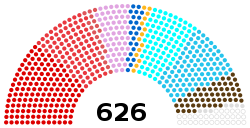National Assembly (French Fourth Republic)
National Assembly Assemblée nationale | |
|---|---|
| 1st, 2nd and 3rd legislatures of the French Fourth Republic | |
| Type | |
| Type | of the French Parliament |
| History | |
| Founded | 28 November 1946 |
| Disbanded | 8 December 1958 |
| Preceded by | Constituent Assembly (Provisional Government) |
| Succeeded by | National Assembly (Fifth Republic) |
| Leadership | |
| Structure | |
| Seats | 626 |
 | |
Political groups | Filled (594)[a]
Vacant (32)
|
Length of term | 4 years |
| Elections | |
| Party-list proportional representation | |
First election | 10 November 1946 |
Last election | 2 January 1956 |
| Meeting place | |
 | |
| Salle des Séances Palais Bourbon Paris, French Republic | |
| Website | |
| Archives | |
The National Assembly (French: Assemblée nationale, [asɑ̃ble nɑsjɔnal] ⓘ) was the lower house of the French Parliament under the Fourth Republic, with the Council of the Republic being the upper house. It was established by the post-war Constitution of 1946, dissolved by the Constitution of 1958 and replaced with a new chamber bearing the same name.
The institutional nature of the parliamentarian Fourth Republic has been described as a source of political instability by historians and jurists.[1][2] The proportional voting system of the 1946 legislative election led to a "tripartisme" dominated by the Communists, the Socialists and the Popular Republican Movement, that ended up with the step down of communist ministers from the government in 1947.[3]
The electoral law of 9 May 1951 introduced a voting system based on affiliations: it combined proportional representation with the possibility for the ballots to join forces in the counting and distribution of votes. This system was intended to give a stable majority to the government, as well as to reduce the influence of the Communist Party and the Rally of the French People in the parliament.[3]
By creating the French Union, the 1946 constitution allowed a rising number of black deputies from French West Africa, French Equatorial Africa and French West Indies to be elected in the Assembly: from only one Senegalese representative in the Third Republic, black deputies were 21 in 1946 and 30 in 1958, the year of the founding of the Fifth Republic.[4]
History
[edit]The Constitution of 1946, adopted by the Constituent Assembly on 29 September 1946 and approved by referendum on 13 October 1946,[5] led to the creation of a new bicameral parliament. The lower house, named Chamber of Deputies under the Third Republic, became the National Assembly.
Composition
[edit]| Term | Composition |
|---|---|
| I (1946 election) |  |
| II (1951 election) |  |
| III (1956 election) |  |
References
[edit]- ^ Colliard, Jean-Claude (1 January 1978). Les régimes parlementaires contemporains (in French). Presses de Sciences Po. ISBN 9782724685923.
- ^ Lascombe, Michel (2005). Le droit constitutionnel de la Vème République (in French). L'Harmattan. p. 26. ISBN 9782747594141.
- ^ a b "L'instabilité politique - Histoire - Histoire de l'Assemblée nationale - Le Gouvernement provisoire et la Quatrième République (1944-1958) - Assemblée nationale". www2.assemblee-nationale.fr. Retrieved 28 August 2019.
- ^ Guillemin, Philippe (1958). "Les élus d'Afrique noire à l'Assemblée nationale sous la Quatrième République". Revue française de science politique. 8 (4): 861–877. doi:10.3406/rfsp.1958.392489.
- ^ Foundation for Foreign Affairs (1947). A Constitution for the Fourth Republic. p. 75.
Notes
[edit]- ^ Last election of 2 January 1956.
- ^ Due to the Algerian War.
